The Checker Maven
The World's Most Widely Read Checkers and Draughts Publication
Bob Newell, Editor-in-Chief
Published each Saturday morning in Honolulu, Hawai`i
Contests in Progress:
Marvin J. Mavin: Spring Break

The Detroit Doublejumpers of the National Checker League were on spring break, and their superstar captain, Marvin J. Mavin, had a week off.
Now recall that in our last story, Marvin got into trouble when his Valentine's Day gift to his wife, Priscilla, was a love poem written by a computer. It took Marvin a little while to make things up with her, but a $100,000 emerald ring was a good first step. However, there was to be a second step.
"You're forgiven," Priscilla said over Sunday morning breakfast in the breakfast room of her 5,000 square foot luxury condo, "or at least almost."
"Huh?" Marvin replied. "Ain't that fancy ring enough?"
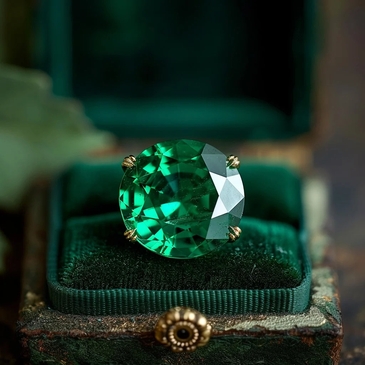
"I do appreciate the gift, dear, even if it was a couple of weeks late, and even if the stone was a bit on the small side. However, there's one thing you'll need to do for me and then we'll say you've paid your debt to me."
"Do? Like what?"
"Well, seeing as how you're off this week, and seeing as how on Saturday night there's the annual black-tie fundraiser for the Art Museum, I thought you might help out."
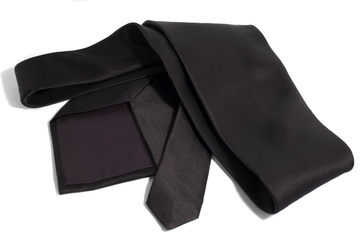
Image: Scott J. Waldron
"Black tie --- I ain't got no black tie."
"Oh, Marvin, we've been through this before. You'll rent from the usual place, Twirly Tuxedos and Gaudy Gowns. But that's not the point."
"So what is?" Marvin ws beginning to shake his foot and push his fork around his plate, sure signs of nervousness.
"Why, I've set up an exhibition! You'll play a game against your old friend, Dmitri Tovarischky. Attendees will bet on the winner, with all of the money going to the Art Museum. The one who bets the most on the actual winner will be named Patron of the Year, a great honor. Most attendees would pay several hundred thousand for that title."

Dmitri Tovarischky
"This is nuts!" Marvin exclaimed. "Dmitri ain't my old friend or any kind of friend neither. He's a total ---"
"Don't say it, Marvin. In any event complaining won't help. It's all arranged. You're committed."
"What kind a folks would pay a few hundred grand for some dumb museum title? And I ain't gonna play wearing no monkey suit. In fact I ain't gonna play at all!"
"I would be careful if I were you, dear. Yes, you are going to play. Yes, you are going to wear a tuxedo. And especially, you are going to be polite to the people who support the museum with large contributions. In fact, a little fawning, bowing and scraping might be in order."
The discussion didn't go on for much longer. Marvin knew there was no way out. But Dmitri? The very thought of him made Marvin ill. (Editor's note: Marvin's experiences over the years with Dmitri have been related in a number of previous Checker Maven stories.)
It was the night of the gala. Marvin had spent an uncomfortable couple of hours at Twirly Tuxedos getting fitted for a rental that would cost about $1,000 for this one event.

Marvin and Priscilla arrived at the downtown Swank Hotel at a fashionably late hour. The hotel ballroom was filling with men in formal attire, and women in evening gowns and sporting glittering jewelry. Admission alone was $50,000 per person. It was an affair for the wealthiest of the Detroit area's wealthy.

Dinner was something that was said to be duck but was surely the usual banquet rubber chicken, accompanied by unidentifiable side dishes. But, as it was prepared by a three star Michelin chef, everyone raved about it and said how it was well worth the $50,000 price of admission. Marvin started to make a remark about the food but Priscilla quickly cut him off. "Remember, Marvin, grovel a little tonight," she admonished.

There was a betting board for the upcoming checker match. The board only announced the total amount bet but didn't break it out by player or bidder. By the time the event's emcee announced that the match would commence in just 30 minutes, the total pool was at nearly ten million dollars. The emcee noted that betting was running quite a bit behind the previous year and that the patrons needed to hurry if they were to have a chance at becoming Patron of the Year.
Soon Marvin and Dmitri were called to the front of the ballroom, where a small stage had been set up with a table and chairs. An elegant checker set and board was on the table.
"Ladies and gentlemen," the emcee announced, "tonight two top professionals will contest a match for charity. The winner will be awarded the prestigious title of Art Museum Checker Champion and a generous grand prize of two museum entry tickets, good for use on any Monday morning of the winner's choice. That's a $20 value.
"The contestants will play on a diamond encrusted checker board, with ruby and ivory checker pieces. Use of this set was donated by Toys for the Rich Only, who stand ready to meet all your high-end requirements for one of a kind toys and games."

Marvin and Dmitri met at center stage amid great applause from the patrons. The betting pool closed at $15 million, which the emcee declared to have now exceeded the previous year's amount.
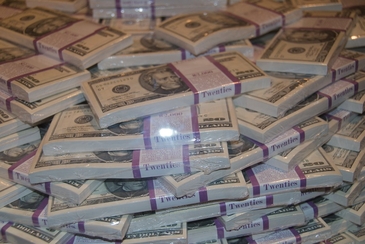
There was a very brief and unenthusiastic handshake between the two rivals.
"Checkers boy," Dmitri said, "we meet one time more and I am ready for crushing you again like last time."
"Uh, listen here you little Commie, I won that game as I recall, and I'm gonna win this one too."
"Checkers boy is dreaming," said Dmitri. "Prepare for humilating losing."

The match began. Other than the clinking of champagne and wine glasses, the ballroom was exceptionally quiet. All eyes were on the stage as the game progressed.
After about an hour, the following position was reached with Marvin to play.
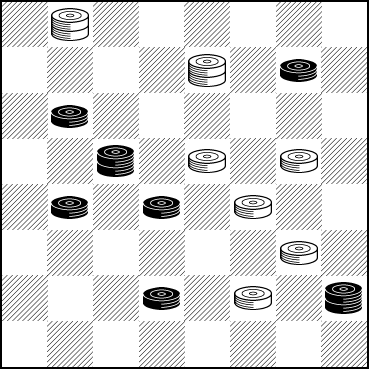
WHITE
White to Play and Win
W:WK1,K7,15,16,19,24,27:B8,9,K14,17,18,26,K28
Dmitri was grinning. "Now what," he said. "What you are going to do, checkers boy? I suggest resign. Save some time. I am wanting nice glass of champagne to celebrate victory and don't want to wait more longer."
"Stuff it," Marvin said.
The patrons knew the game was at a critical juncture. The silence in the ballroom broke and cheers of both "Marvin!" and "Dmitri!" went up. Finally, in the increasing din, Marvin made his move.
Did you ever play checkers wearing a tuxedo? We suppose it's possible, although surely not a common thing. Do you have a checker rival at the level of Dmitri's rivalry with Marvin? We certainly hope that if you do, you are on more cordial terms. But all that aside, would you be able to win this match? See if you can, and then click on Read More to see the solution and the rest of the story.![]()
The Side of the Road

It looks like someone is over on the side of the road. That might be okay, or it might not. It depends on the circumstances.
In today's speed problem, all of the pieces are on the side of the road, but White especially is sidelined and a piece down besides.
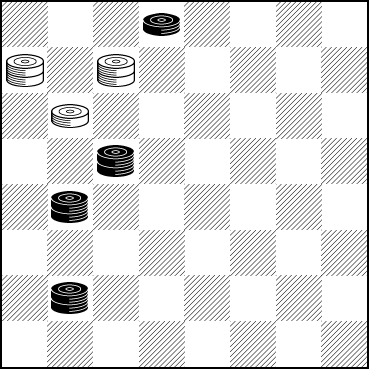
WHITE
White to Play and Draw
W:W9,K6,K5:B2,K25,K17,K14
There's a draw here, and it won't be a lot of trouble for you to find it. See how quickly you can solve this one. An expert should see it at once but the problem is well within the range of an attentive novice. Don't stand on the sidelines; solve this one and click on Read More to verify your solution.![]()
A Twin

Image by 'Suzu2' under Creative Commons license
In today's Checker School column, we continue with what Andrew J. Banks, in his eclectic book Checker Board Strategy, calls a "beginner's problem" although he does make something of a retraction of that statement, as we shall see.
Mr. Banks tells us that a problem whose terms contains the phrase "Either to Play" is known as a twin, for fairly obvious reasons. He gives the following example.
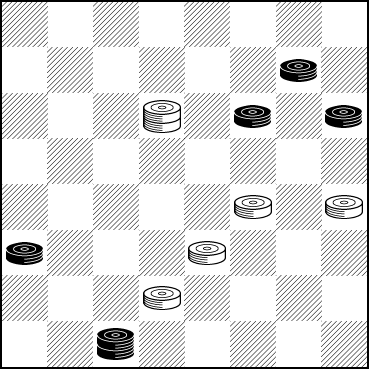
WHITE
Either to Play, White to Win
W:WK10,19,20,23,26:B8,11,12,21,K30
Although we've shown this from the White side, the terms in fact do hold. We don't see a lot of problems of this type and it's quite interesting. Is it, in fact, easy enough for beginners? Mr. Banks recants by saying, "Tough problem for a BEGINNER!!!"
Tough or not will depend on your skill level but we think it will entertain most everyone. Find both solutions, if you can, and then click on Read More to see the solutions.![]()
Unsure

Have you ever been unsure about something? We all have. Not everything in life is certain. Sometimes we just give something our best effort and let the chips fall as they will.
Being unsure and having things work out is great. But that can be taken a step further. We can do something and have it work out all the while not knowing why we did what we did and why it worked out. Some might call this luck. Others might call it hidden intuition. However everyone, we would think, would welcome a positive outcome.
Regular contributor Lloyd Gordon of Toronto won in the following position against "Gosh Josh" Gordon in one of their nightly over the board contests. Lloyd's comment was, "I won without even knowing what the move did."
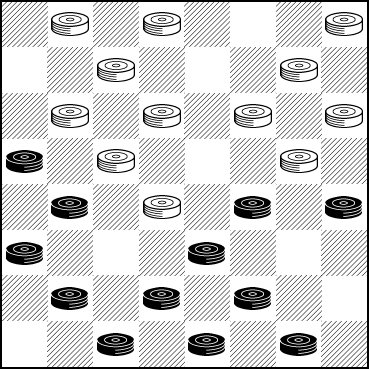
BLACK
Black to Play and Win
B:W32,31,29,27,25,24,23,22,21,19,17,15:B20,16,14,13,12,10,8,7,6,3,2,1
This one isn't difficult at all and we think it qualifies nicely for a traditional beginning of the month speed problem. We do, however, suggest that you try to have an idea of what your candidate moves may do. See how quickly you find the win, knowing for sure that clicking on Read More will show you the solution.![]()
Post-Holiday Blahs

The holiday season is over for another year, and the post-holiday blahs are inevitable. After the fervor of recent weeks, we're supposed to magically return to normal. It's even worse in much of mainland North America, which is in the dead of winter with short days and cold nights. Feeling a bit down is not unexpected.
We can't bring back that holiday excitement, nor can we make the days longer or warmer. Those latter things will only come further on as the earth continues its revolution about the sun. But we can bring you a short, snappy, pleasing, and rather easy checker problem, one that will give you some instant gratification without taxing your likely tired brain. It was sent to us by Lloyd and "Gosh Josh" Gordon and comes from actual play.
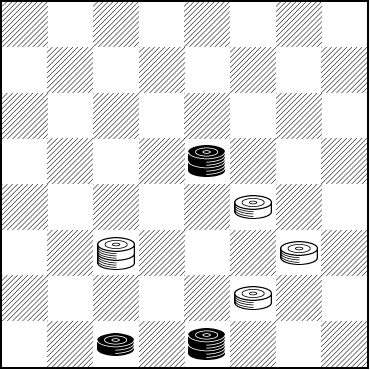
BLACK
Black to Play and draw
B:W14,9,6,K11:B3,K18,K2
This isn't just a "blah" problem and you can solve it before you can say "blah blah blah." You likely won't need help but you can always click on Read More to verify your solution.![]()
20th Anniversary

With today's column, The Checker Maven celebrates its 20th anniversary of publication.
We never thought we'd publish for so long, and we now stand, at least in terms of longevity if nothing else, alongside some of the great publications of days gone by. Certainly in recent times only a handful of publications have been around longer.
Our original plan was for 10 years. We increased that to 15 and then we said we'd carry on as long as we could. Your editor's recent successful eye surgery encourages us to continue even beyond the 20 year mark (we had been doubtful due to deteriorating vision). Old age of course is catching up with us, but who knows whether or not there might be a few more years of publication yet to come. As of this moment, we plan to carry on.
In our heyday we had as many as 7,000 weekly readers. As checkers has continued to slip out of the public eye, our circulation has dropped substantially but we still boast around 2,000 weekly readers. Not bad, actually!
With our stories and our own brand of humor, with our no compromise intellectual attitude towards the game and its players, we have tried to make checkers fun and interesting, and we'd like to believe that over the years we've done our part in attempting to popularize the game and demonstrate its many attributes.
Of course without you, our reader, none of this ever would have happened and we are grateful to each and every one of you.
So to celebrate we'll reach into our dwindling store of problems by the late lamented grandmaster problemist Ed Atkinson. Ed was our correspondent for many years and we think it is fitting for this column to honor him. Here is a problem which Ed, in his inimitable fashion, titled Seldom Scene.

WHITE
White to Play and Win
W:B1,19,K14,K30:W15,16,26,K2,K20
Stay on the scene and solve the problem, after which you can click on Read More to see the snappy solution.![]()
Composing Contest 77: The End of the Road

It's been a long journey but we've reached the end of the road, as we announce #77 in Bill Salot's wonderful series of checker problem composing contests; #77 will indeed be the last. The Checker Maven has been privileged to have published 22 of them and to have archived the rest for continued enjoyment into the future.
But all is not lost; Mr. Salot says he will provide us with problems on a continuing basis for us to publish from time to time in our regular weekly columns.
For now, however, let's focus on Contest 77, which Mr. Salot calls Entertainers. You can read more about it and try four creative and indeed entertaining problems on the contest page.
First, though, we'll let you try a "teaser" problem called Surprise, Surprise, composed by Roy Little and originally published in February 2021. You'll see where the title comes from when you solve the problem.
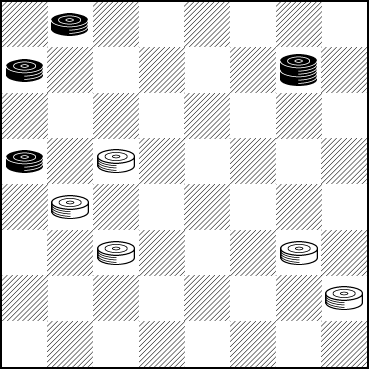
WHITE
White to Play and Win
W:W14,17,22,24,28:B1,5,K8,13
Surprise yourself by solving this one, and then spring a surprise by clicking on Read More to see the solution. And then, be sure to visit the contest page and vote for your favorite!![]()
Problem Composing Contest 76: Two-Part Blends

The two, two-part blends above are symbolic of Bill Salot's newest Problem Composing Contest. No, Bill didn't switch from checkers to coffee--- we understand in fact that he personally eschews coffee--- but what he has done is to present us with two two-part blend problems which will challenge and entertain you as never before. You can find them on the contest page, where you are invited and requested to vote for the one you like best.
As a sample of what awaits you, here is a previously unpublished two-part problem composed by Mr. Salot himself. He calls it The Albatross for two reasons. One is that the setting (somewhat) resembles an albatross. The other is that an Albatross symbolizes something that makes accomplishment particularly difficult, as in the expression "an albatross around one's neck" which takes its derivation from Samuel Taylor Coleridge's celebrated poem The Rime of the Ancient Mariner.
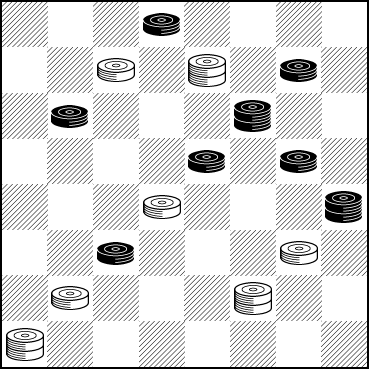
WHITE
White to Play and Win
W:W6,K7,18,24,25,K27,K29:B2,8,9,K11,15,16,K20,22
Will this problem be the albatross that hangs around your neck? We certainly hope not, for after giving it a go you can always click on Read More to see the solution.![]()
Labor Day 2024

You might be a blue collar worker, such as the plumbers shown above.

Or you might be a white collar worker or even a business executive.
Labor Day is for all of you and for all of us, as we recognize once again that all honest work deserves respect, and that every worker is an important contributor to our economy and our way of life. It's a great American (and Canadian) holiday.
For this celebration, in our Checker Maven columns we typically turn to Tom Wiswell, a great American checker champion, checker writer and teacher, and one of the most outstanding checker problemists in the history of the game. Today we invite you to try out The Sea Dog, which Mr. Wiswell dedicated to William Grover, the brother of another checker great, Ken Grover. William Grover served in the Merchant Marine during World War II and became a prisoner of war.
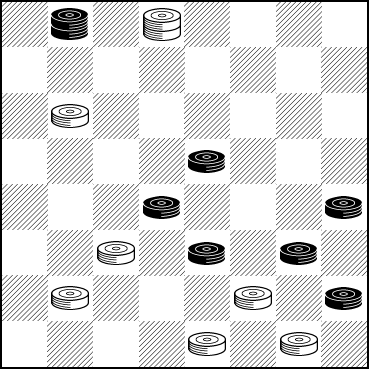
WHITE
White to Play and Win
W:WK2,9,22,25,27,31,32:BK1,15,18,20,23,24,28
As is typical for Mr. Wiswell, this is an elegant problem and you will enjoy solving it. When you're done, click on Read More to see the run-up and the solution.![]()
Precision
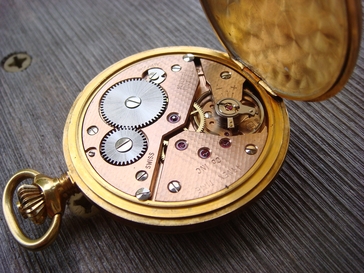
There's the classic precision of a Swiss watch. There's the precision of a talented musician playing a difficult solo piece or the precision flying of Air Force pilots. The list goes on, and in our game of checkers, there is precision, too. Some lines of play leading to a win or saving the draw require extreme precision wherein one false move leads to either failure to bring home the win or an ignominious defeat.
The following position is from a recent game played between regular Toronto based contributors Lloyd and "Gosh Josh" Gordon. While after the first few moves many variations are possible, precision play is required by White to obtain a draw--- and careful play is required by Black to avoid a possible loss if a wrong move is made.
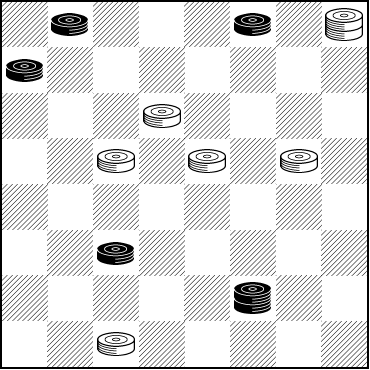
WHITE
White to Play and Draw
W:WK4,10,14,15,16,30:B1,3,5,22,K27
How precise is your play? See if you can draw this one, and then click your mouse precisely on Read More to see one version of the solution.![]()
The Checker Maven is produced at editorial offices in Honolulu, Hawai`i, as a completely non-commercial public service from which no profit is obtained or sought. Original material is Copyright © 2004-2025 Avi Gobbler Publishing. Other material is the property of the respective owners. Information presented on this site is offered as-is, at no cost, and bears no express or implied warranty as to accuracy or usability. You agree that you use such information entirely at your own risk. No liabilities of any kind under any legal theory whatsoever are accepted. The Checker Maven is dedicated to the memory of Mr. Bob Newell, Sr.

